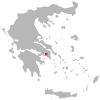Elefsina Archaeological Site
Ancient Eleusis is located 17 km (aprxo. 11 miles) from Athens, in the modern town with teh same name. It was the location of a very important sanctuary where the Eleusinian Mysteries (Elefsinian Mysteries) took place every year around the end of what we now call September.
The Eleusinian mysteries were an initiatinon ceremony to the cult of Demeter and revolved around the myth of Persephone. The mysteries lasted nine days. The mysteries took place in the Archaic Era but aquired special significance in Classical and Hellenistic times. Eleusis and the mysteries retained their importance during the Roman era, and the site was occupied even in Byzantine times as the archaeological record shows.
Photo Gallery
 The Roman Courtyard
The Roman Courtyard
The Roman approach to the the center of the sanctuary was built by Hadrian and construction was completed by Marcus Aurelius. It was the main entrance to Eleusis and led to the rest of the Sanctuary through the Great Propylaia.


 The Cistern
The Cistern
It was made watertight with a hard plaster surface. It has two parts that allow the water to be cleaned. One part collects the water after the sediment was settled in the other. The Small Propylaea
The Small Propylaea
The arched channels of a heavy door are cut deep in the hard marble floor. The two parallel grooves in the foreground were cut intentionally to channel carriage wheels through without damaging the rest of the entrance. The present ruins of the Small Propylaea were built by Appius Claudius Pulcher in 54 BCE on the site of the earlier Classical construction built during the Peisstratos era. Earlier Archaic structures are buried below.
The present ruins of the Small Propylaea were built by Appius Claudius Pulcher in 54 BCE on the site of the earlier Classical construction built during the Peisstratos era. Earlier Archaic structures are buried below.-
 The Plutonion
The Plutonion
The Cavern eludes to an entrance to Hades and as such it provides a symbolic (for us) passage for Persephone to descent and ascent every year. The temple of Pluto was built in the Archaic Era but was remodeled many times down to the Roman Era. -

-
 The Bouleuterion (Voulefterion)
The Bouleuterion (Voulefterion)
It was the building where the council of Eleusis was housed. Built in the 3d c. BCE, it had three large rooms with a semicircular plan in the middle. It took the shape of a circular Odeion under Roman administration. -
 The South Gate of the wall of Lykourgos. It was the entrance for those approaching from the harbor.
The South Gate of the wall of Lykourgos. It was the entrance for those approaching from the harbor. -


-

 The Telesterion.
The Telesterion.
This was the central building of the sanctuary where pilgrims were initiated into the Eleusinian Mysteries. It was a large hypostyle hall with seats on all four sides where the faithful sat and watched the rituals. The Hierophantes produced sacred objects and receded texts to covey a positive view of life after death. 




